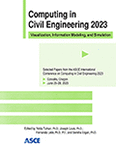Simulation Modeling Efforts in the Construction Industry: Integrated Application of BIM and Agent-Based Modeling
Publication: Computing in Civil Engineering 2023
ABSTRACT
This study investigates the synergies of integrated simulation approaches using building information modeling (BIM) and agent-based modeling (ABM) in construction. These modeling approaches in construction have been bridged by observing the movements of project participants (e.g., laborers, pedestrians), particularly in environments with spatial and temporal constraints. The key objectives of this study are to investigate (1) the issues integrated BIM-ABM modeling can address, (2) the functions each model performs, and (3) the benefits of such an integrated model. To this end, this study employed a systematic review of scholarly literature focusing on applications and synergies of BIM-ABM integration in the construction industry. Studies in this space primarily focused on the optimization of job site evacuation and project management. In the studies, simulation results highlighted benefits to construction projects through supporting safety at work, reduced construction costs, and enhanced productivity.
Get full access to this article
View all available purchase options and get full access to this chapter.
REFERENCES
Abadi, S. T. S., N. M. Tokmehdash, A. Hosny, and M. Nik‐bakht. 2021. “Bim‐based co‐simulation of fire and occupants’ behavior for safe construction rehabilitation planning.” Fire, 4 (4). https://doi.org/10.3390/fire4040067.
Chen, S., Y. Zeng, A. Majdi, A. A. Salameh, T. Alkhalifah, F. Alturise, and H. E. Ali. 2023. “Potential features of building information modelling for application of project management knowledge areas as advances modeling tools.” Adv. Eng. Softw., 176 (December 2022): 103372. Elsevier Ltd. https://doi.org/10.1016/j.advengsoft.2022.103372.
Cheng, J., Y. Tan, Y. Song, Z. Mei, V. J. L. Gan, and X. Wang. 2018. “Developing an evacuation evaluation model for offshore oil and gas platforms using BIM and agent-based model.” Autom. Constr., 89 (February): 214–224. Elsevier. https://doi.org/10.1016/j.autcon.2018.02.011.
Cheng, T., and J. Teizer. 2013. “Real-time resource location data collection and visualization technology for construction safety and activity monitoring applications.” Autom. Constr., 34: 3–15. Elsevier B.V. https://doi.org/10.1016/j.autcon.2012.10.017.
Fioravanti, A., G. Novembri, and F. L. Rossini. 2017. “Improving Proactive Collaborative Design Through the Integration of BIM and Agent-Based Simulations.” Proc. Int. Conf. Educ. Res. Comput. Aided Archit. Des. Eur., 1: 103–108. https://doi.org/10.52842/conf.ecaade.2017.1.103.
Giustini, D., and M. N. Kamel Boulos. 2013. “Google Scholar is not enough to be used alone for systematic reviews.” Online J. Public Health Inform., 5 (2): 1–10.
Islam, M. S., M. P. Nepal, M. Skitmore, and M. Attarzadeh. 2017. “Current research trends and application areas of fuzzy and hybrid methods to the risk assessment of construction projects.” Adv. Eng. Informatics, 33: 112–131. Elsevier Ltd. https://doi.org/10.1016/j.aei.2017.06.001.
Khodabandelu, A., and J. W. Park. 2021. “Agent-based modeling and simulation in construction.” Autom. Constr., 131 (December 2020): 103882. Elsevier B.V. https://doi.org/10.1016/j.autcon.2021.103882.
Leite, F. L. 2020. BIM for Design Coordination: A Virtual Design and Construction Guide for Designers, General Contractors, and MEP. Wiley.
Liu, B., B. Yang, B. Zhang, M. Dong, S. Jiang, and J. Xiao. 2022. “Spatio-temporal deduction of floor construction based on the agent modeling of construction actors.” Autom. Constr., 142 (April): 104487. Elsevier B.V. https://doi.org/10.1016/j.autcon.2022.104487.
Manzoor, B., I. Othman, and J. C. Pomares. 2021. “Digital technologies in the architecture, engineering and construction (Aec) industry—a bibliometric—qualitative literature review of research activities.” Int. J. Environ. Res. Public Health, 18 (11). https://doi.org/10.3390/ijerph18116135.
Marzouk, M., and I. Al Daour. 2018. “Planning labor evacuation for construction sites using BIM and agent-based simulation.” Saf. Sci., 109 (February): 174–185. Elsevier. https://doi.org/10.1016/j.ssci.2018.04.023.
Mirahadi, F., B. McCabe, and A. Shahi. 2019. “IFC-centric performance-based evaluation of building evacuations using fire dynamics simulation and agent-based modeling.” Autom. Constr., 101 (March 2018): 1–16. Elsevier. https://doi.org/10.1016/j.autcon.2019.01.007.
Naticchia, B., A. Carbonari, M. Vaccarini, and R. Giorgi. 2019. “Holonic execution system for real-time construction management.” Autom. Constr., 104 (September 2018): 179–196. Elsevier. https://doi.org/10.1016/j.autcon.2019.04.018.
Okakpu, A., A. GhaffarianHoseini, J. Tookey, J. Haar, and A. Ghaffarian Hoseini. 2019. “An optimisation process to motivate effective adoption of BIM for refurbishment of complex buildings in New Zealand.” Front. Archit. Res., 8 (4): 646–661. Elsevier Ltd. https://doi.org/10.1016/j.foar.2019.06.008.
Ortiz, O., F. Castells, and G. Sonnemann. 2009. “Sustainability in the construction industry: A review of recent developments based on LCA.” Constr. Build. Mater., 23 (1): 28–39. Elsevier Ltd. https://doi.org/10.1016/j.conbuildmat.2007.11.012.
Pan, Y., and L. Zhang. 2021. “Roles of artificial intelligence in construction engineering and management: A critical review and future trends.” Autom. Constr., 122 (August 2020). Elsevier B.V. https://doi.org/10.1016/j.autcon.2020.103517.
Porter, S., T. Tan, T. Tan, and G. West. 2014. “Breaking into BIM: Performing static and dynamic security analysis with the aid of BIM.” Autom. Constr., 40: 84–95. The Authors. https://doi.org/10.1016/j.autcon.2013.12.002.
Raoufi, M., and A. R. Fayek. 2021. “Hybrid fuzzy Monte Carlo agent-based modeling of workforce motivation and performance in construction.” Constr. Innov., 21 (3): 398–416. https://doi.org/10.1108/CI-03-2020-0045.
Saldana, J. 2014. Coding and analysis strategies.
Uddin, M. N., Q. Wang, H. H. Wei, H. L. Chi, and M. Ni. 2021. “Building information modeling (BIM), System dynamics (SD), and Agent-based modeling (ABM): Towards an integrated approach.” Ain Shams Eng. J., 12 (4): 4261–4274. The Authors. https://doi.org/10.1016/j.asej.2021.04.015.
Wuni, I. Y., and G. Q. Shen. 2020. “Barriers to the adoption of modular integrated construction: Systematic review and meta-analysis, integrated conceptual framework, and strategies.” J. Clean. Prod., 249. Elsevier Ltd. https://doi.org/10.1016/j.jclepro.2019.119347.
Information & Authors
Information
Published In
History
Published online: Jan 25, 2024
ASCE Technical Topics:
- Architectural engineering
- Bridge engineering
- Bridges
- Bridges (by type)
- Building information modeling
- Building management
- Buildings
- Construction engineering
- Construction industry
- Construction management
- Engineering fundamentals
- Foot bridges
- Infrastructure construction
- Models (by type)
- Project management
- Simulation models
- Structural engineering
- Structures (by type)
Authors
Metrics & Citations
Metrics
Citations
Download citation
If you have the appropriate software installed, you can download article citation data to the citation manager of your choice. Simply select your manager software from the list below and click Download.
